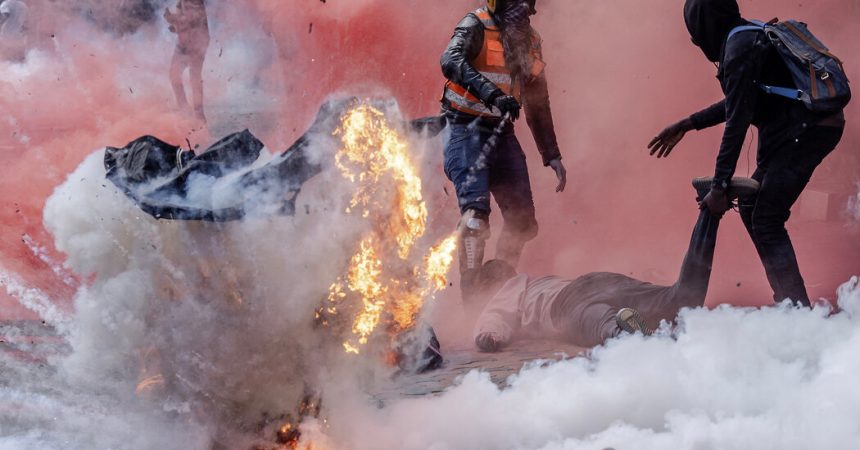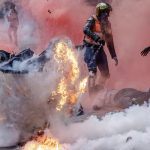Major protests rocked Kenya
Kenya’s president, William Ruto, deployed the military yesterday to crack down on what he called “treasonous” protesters, after demonstrators furious over the passage of a package of tax increases stormed the Parliament building in the capital, Nairobi, climbed in windows and set fire to the entrance.
The police fired tear gas and guns. At least five people were reported dead from gunshot wounds, and more than 30 others were wounded, according to a joint statement by Amnesty International and several Kenyan civic organizations. The numbers could not be independently confirmed.
Kenyans have widely criticized the bill, saying it would drive up the cost of living for millions. But the government has argued that the legislation was crucial to secure revenue for important initiatives.
What’s next: Ruto now has two weeks to sign the legislation into law or send it back to Parliament for revisions.
Other protests: The demonstrations seemed to be spreading beyond Nairobi, as protesters blocked streets with burning tires in Nakuru, a city some 100 miles from the capital. Last week, at least one person was killed and 200 others were injured across the country, Amnesty International said.
Photos: Here’s what it looks like on the ground.
Assange agreed to a plea deal
Julian Assange, the founder of WikiLeaks, has agreed to plead guilty to a single felony count in exchange for his release from a British prison, ending his long standoff with the U.S.
During a hearing today in a U.S. court in the Northern Mariana Islands, Assange is expected to be sentenced to about five years, which he has already served in Britain. He is then expected to return to Australia.
Assange became alternately celebrated and reviled for revealing state secrets in the 2010s, including material about U.S. military activity in Iraq and Afghanistan, as well as confidential diplomatic cables. Here’s what we know about Assange and his plea deal.
What’s next: Assange’s plea deal could set a chilling precedent for press freedoms in the U.S., my colleague Charlie Savage writes in an analysis.
Israel’s top court ruled on drafting ultra-Orthodox Jews
Israel’s Supreme Court ruled unanimously yesterday that the military must begin drafting ultra-Orthodox Jewish men. The decision has threatened to split Prime Minister Benjamin Netanyahu’s coalition government, which depends on two ultra-Orthodox parties.
All nine judges agreed that there was no legal basis for the military exemption. The issue, which has long been a source of tension between secular Israelis and the ultra-Orthodox community, has only grown more heated as the war in Gaza continues and reservists are called to serve second and third tours.
What’s next: There’s no timeline for conscriptions, but any such move is almost certain to meet fierce religious resistance. As a means to pressure the ultra-Orthodox community to accept the judgment, the court said that the government could suspend subsidies for religious schools that do not adhere to the ruling.
Hunger in Gaza: A U.N.-backed panel of experts said that almost half a million people face starvation and that the war had created a catastrophic lack of food.
MORE TOP NEWS
Russia-Ukraine
Wood-fire-oven pizzerias, once rare outside Italy, are now fixtures in many American cities. The result? Pizza in the U.S. is better than it has ever been, writes my colleague Brett Anderson — who ate dozens of pizzas in 18 states to report this article.
Planning a trip? Here are 22 of the best pizza restaurants across the U.S.
CONVERSATION STARTERS
SPORTS NEWS
-
Hockey: The Florida Panthers beat the Edmonton Oilers to win the Stanley Cup.
-
Tennis: Roger Federer’s graduation speech at Dartmouth College has become a hit: “The truth is, whatever game you play in life, sometimes you’re going to lose,” he said.
-
Baseball: Read about how an obsession with strikeouts changed the sport.
SPACE
China’s trip to the dark side of the moon
China is now the first country to retrieve soil from the far side of the moon and bring it back to Earth. The sample, which landed in Inner Mongolia yesterday on the Chang’e-6 lander, could hold clues about the origins of the moon and Earth.
The far side of the moon is something of a mystery: It never faces Earth, so direct communication with landers on the lunar far side is nearly impossible, making the area difficult to reach successfully. Some scientists hope China’s missions could advance the global scientific understanding of the solar system.







